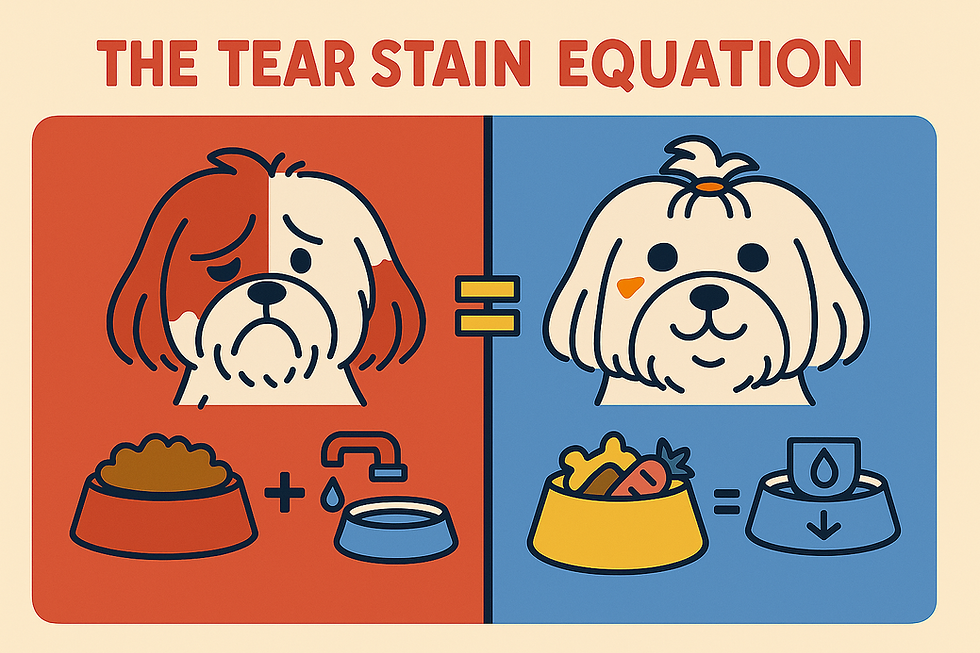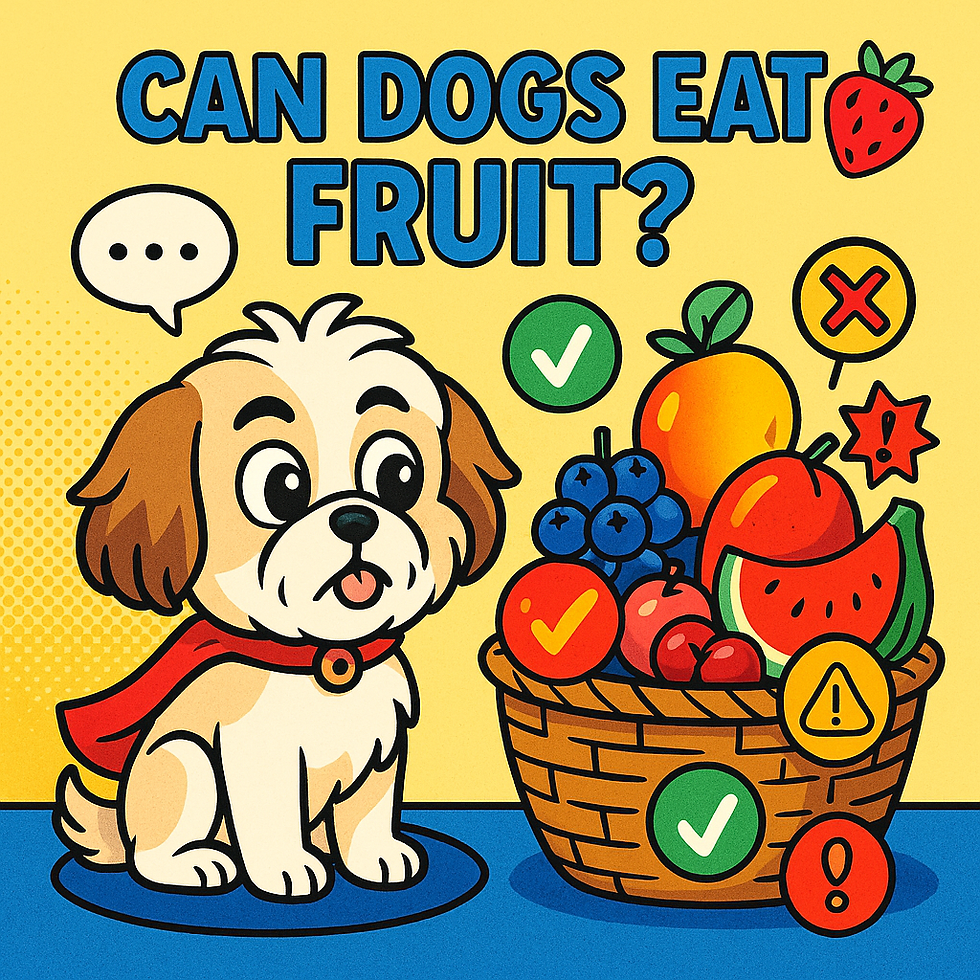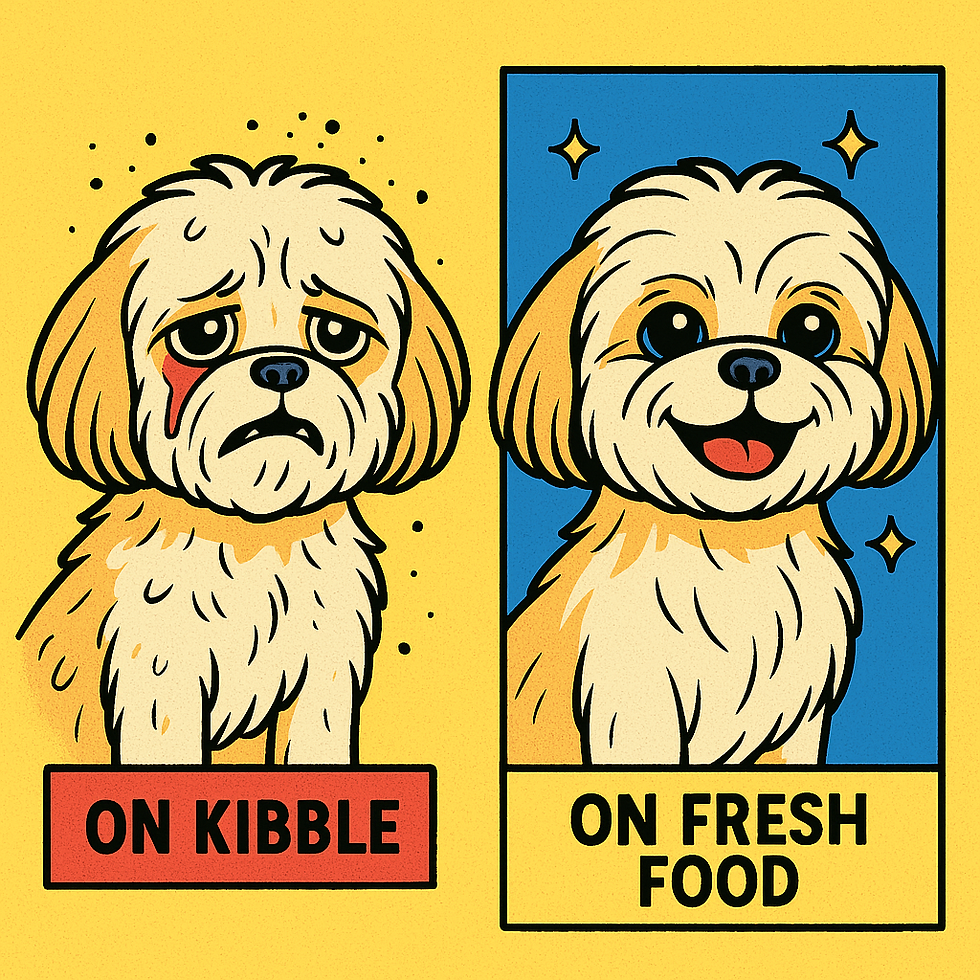Tear Stains in Dogs: What They Really Mean (And How to Fix Them Naturally)
- June

- Jul 6
- 5 min read

Tear stains—you know, those reddish-brown streaks under a pup’s eyes? I’ve never had them (humblebrag), but I’ve seen some of my fellow fluffballs struggle with them. And let’s just say: it’s not just a beauty issue—it’s a health clue.
Since I’m all about living our best, healthiest lives (and because my hooman is obsessed with research), I decided to dig deep into the why, how, and what-you-can-do of tear stains. I even consulted the big dog experts (the ones with degrees and stethoscopes). Let’s get into it.
So... What Are Tear Stains Anyway?
Tear stains are those brownish or reddish marks you see under some dogs’ eyes. The culprit? A molecule called porphyrin. It’s found in our tears (also saliva and pee—ew), and when it sits on our fur and gets exposed to light, it oxidises and causes staining.
Common Signs:
Rusty streaks under the eyes
Damp or smelly skin
Crusty patches or hair loss near the eyes
Not cute. Also not always harmless.
Why Do Some Dogs Get Tear Stains?
Turns out, tear stains usually show up when there’s more tearing than normal—and that can happen for a bunch of reasons. Let’s sniff them out.
1. Blocked Tear Ducts (aka Epiphora)
Normally, our tears drain into our nose. But for some of us (especially flat-faced friends), those ducts are either too tiny or not working right. So the tears spill out and stain our fur.
🧠 “Epiphora can be congenital or acquired. We often see it worsen with age or inflammation,” says Dr. Karen Becker, a renowned integrative vet.(See? I told you I did real research.)
2. Diet Drama
Some kibbles are full of fillers, allergens (hello, corn and wheat), and mystery meats. That can cause low-key inflammation and make our eyes all watery. A 2017 study in the Journal of Animal Physiology and Animal Nutrition even said processed foods can mess with tear production.
3. Eye Irritation
Wind, dust, fur poking the eye, even plastic food bowls (they’re germ magnets)—all of these can make your eyes tear up.
4. Yeast Overgrowth
When the skin under the eye stays moist, yeast (especially Malassezia) can start to party. The result? Smelly stains, itchiness, and worse.
5. Mineral-Laden Tap Water
Too much iron or other minerals can make our bodies push out more porphyrins in tears. Filtered water is bougie—but in this case, it helps.
Holistic Ways to Tackle Tear Stains (That Actually Work)
No shade to the bleach wipes and “miracle” serums, but masking the problem isn’t the vibe. Let’s talk real solutions—from the inside out.
🥦 1. Upgrade That Bowl: Fresh Food FTW
Tear stains often disappear when dogs switch from kibble to a fresh, anti-inflammatory diet. Think omega-3s, antioxidants, and no fillers.
📌 “Many of my patients’ tear stains clear up within 6–8 weeks of switching from kibble to a fresh or raw diet,” says Dr. Judy Morgan, holistic vet and author.Told ya. Food matters.
🌿 2. Add These Goodies to the Bowl
Ingredients That Help:
Omega-3s (from salmon, sardines, krill oil): reduce inflammation
Antioxidants (from blueberries, turmeric, kale): fight stress at a cellular level
Milk thistle & dandelion greens: support the liver (aka the body’s detox boss)
Probiotics & digestive enzymes: improve gut health = fewer toxins
Quercetin: a natural antihistamine for allergy-prone pups
Clean proteins: like turkey, duck, or lamb (especially helpful if chicken is a trigger)
🧬 A study in Veterinary Dermatology (2018) found that dogs with tear staining had more oxidative stress and gut imbalance—things diet can totally fix.
Ingredients to Avoid:
Wheat, corn, soy
Artificial preservatives (BHA, BHT)
Food dyes (just no)
Overly starchy or carb-loaded kibble
Basically, if it sounds like it came out of a vending machine, maybe don’t eat it.
💧 3. Drink Like Royalty—Filtered Water Only
Switch to reverse osmosis or spring water. It may reduce minerals that cause excess porphyrin buildup. Also: it tastes fancier.
✂️ 4. Keep That Face Fresh and Dry
Daily cleanup = big difference. Use:
Chamomile tea (cooled down!) for soothing antimicrobial wipes
Saline or diluted colloidal silver
Unscented pet wipes with aloe
Soft microfiber cloths (because we deserve luxury)
When It’s Time to See the Vet
If the stains get worse, smell weird, or come with redness and goop—please tell your hooman to talk to your vet. Some stains are signs of:
Eye infections
Conjunctivitis or ulcers
Dental issues (yup, they’re connected)
Eyelid issues like entropion
Allergies or chronic inflammation
Don’t just cover up the symptom—solve the mystery, Scooby-Doo style.
Shih Tzus & Tear Stains: The Drama Is Real
I’m a Shih Tzu, so I know a thing or two about our unique face structure. Even though I’ve never had tear stains, a lot of my floofy cousins do. Why?
Flat faces + shallow eye sockets = tear drainage issues
Hair around the eyes = possible irritation
Skin folds = moist environments where yeast love to hang out
To Trim or Not to Trim (Around the Eyes)
This one gets people barking.
Option 1: Grow It Out + Tie It Up
If you keep the hair long and tie it into a topknot, it stays out of the eyes and doesn’t poke.Great—if your hooman keeps it clean and detangled every day.
Option 2: Trim It Short (the Right Way)
If the long hair keeps falling in your eyes or gets messy, ask your groomer to do a gentle rounded trim.Sharp or blunt cuts = bad. Soft and skilled trims = yes.
🐶 “Neglected long hair causes more problems than neatly trimmed short fur. Just make sure hair isn't pointing inward or cut too bluntly,” says Dr. Mona Gupta, holistic vet.
My rule? Comfort over cosmetics. Just don’t let hair sit wet under your eyes all day—whether it’s long or short.
Final Woof
Tear stains might seem like a small thing, but they can tell a bigger story about your health. If you're seeing chronic staining, don’t just wipe it away—dig into the root cause.
Between better food, filtered water, natural remedies, and a solid grooming routine, most pups see major improvements in just a few weeks. Plus, it’s a great excuse to ask for blueberries and salmon snacks.
You deserve a clean, comfy face—not because it looks good on Instagram (though it does), but because your health is worth it.
Discover the real causes of tear stains in dogs and how to fix them naturally—diet tips, expert quotes, and Shih Tzu-specific advice included.
tear stains in dogs | dog tear stains | tear stain removal for dogs | causes of tear stains in dogs | dog eye discharge | red stains under dog eyes | dog face stains | tear stains Shih Tzu | dog eye cleaning | epiphora in dogs | dog grooming eye area | tear stains natural remedy | how to get rid of tear stains in dogs naturally | what causes tear stains in dogs | best food for dogs with tear stains | are tear stains in dogs a health problem | holistic remedies for dog tear stains | diet to reduce tear stains in dogs | why does my Shih Tzu have tear stains | natural treatment for dog eye stains






Comments